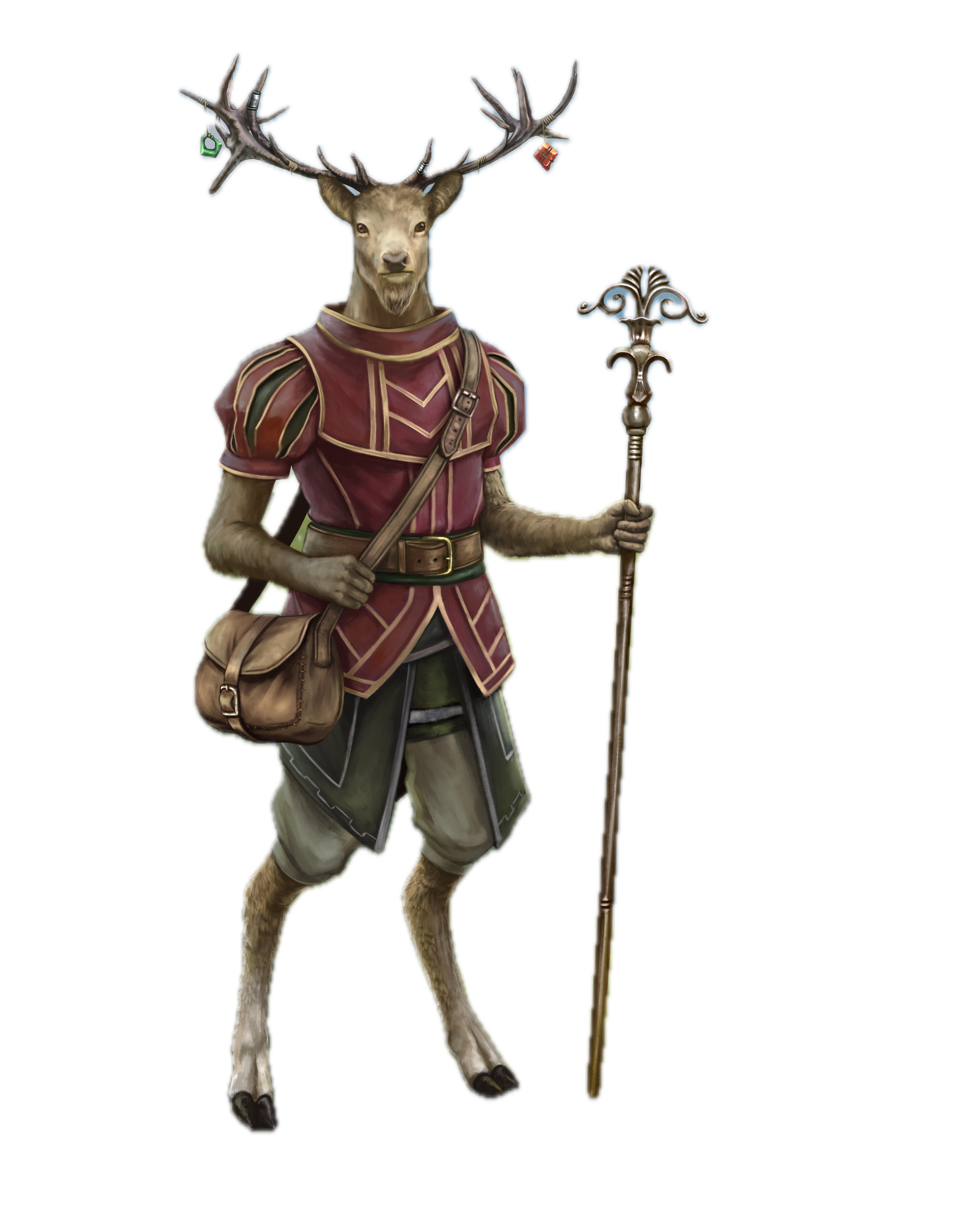Cervid

Cervid Traits
Characters with the cervid heritage share a variety of traits in common with one another.
Age: Cervids mature and age at a similar rate to humans.
Size: Most cervids are slightly taller than humans, typically standing between 6–7 feet tall (not including their antlers) and weighing between 150 and 300 pounds. Your size is Medium.
Speed: Your base walking speed is 30 feet.
Fleet-Footed. You may use a bonus action to Hide or Disengage
Naturally Shod. You have a pair of cloven hooves instead of bare feet, meaning you cannot wear regular footwear such as boots and other shoes. However, your hooves are naturally hard and tough. Choose one type of terrain your deerlike form is adapted to: arctic, desert, forest, grassland, or mountain. You ignore naturally-occuring difficult terrain in that environment. You also take half damage from sharp terrain hazards, such as sharp rocks or broken glass.
Specialized Senses. You gain an expertise die on Perception checks made within the terrain you chose for your Naturally Shod feature.
Cervid Gifts
Cervids come in a variety of shapes and sizes, from slim and elegant to broad and barrel-chested. In addition to the traits found in your cervid heritage, select one of the following gifts.
Fleet Feet
While all cervids are quick on their hooves, you are especially aware and agile. You gain the following traits:
Alert Senses. You gain proficiency in Perception checks.
Bounding Vault. You may make a 10-foot leap in any direction. This leap does not provoke opportunity attacks . You may use this ability a number of times equal to your proficiency bonus per long rest .
Cervine Sprint. Your base Speed increases by 5 feet
Regal Antlers
While plenty of cervids have antlers, yours are particularly impressive—and dangerous. While this means you cannot wear headgear such as helmets, circlets, and diadems, you gain the following traits:
Intimidating Presence. You gain proficiency in Intimidation checks. You can always choose to use Strength when making Intimidation checks.
Natural Weapons. Your antlers are more than just for show. Choose bludgeoning or piercing damage. As a bonus action you may make an unarmed strike, dealing damage of the chosen type equal to 1d6 + your Strength modifier. This strike does not require the use of your hands to execute
Cervid Paragon
When you reach 10th level, you exemplify the best aspects of your kind and gain one paragon gift from the following list.
Like the Wind
Your Speed increases by 10 feet. You ignore difficult terrain when you Dash. When you make a melee weapon attack against a creature, until the end of your turn you do not provoke opportunity attacks from it.
Monarch of the Wilds
You gain an expertise die in Intimidation checks. Additionally, as a bonus action, you can draw on the terrifying majesty of the wilderness, stomping and pawing at the ground or giving a battle cry. All creatures you choose within a 30-foot radius to make a Wisdom saving throw versus your passive Intimidation. On a failure, they become frightened of you until the start of your next turn. You may use this ability a number of times equal to your proficiency bonus per long rest .
Cervid Culture
Most cervids tend to form extended, closeknit family groups where children are raised communally. While some of these families are sedentary, settling into cities and villages, many cervid groups in rural areas opt for a more transient lifestyle, foraging as they go. Obligate vegetarians, any hunting cervids participate in is almost always for fur, feathers, and hides, and they frequently enlist the aid of others who will benefit from the meat produced by their kills. Whether cosmopolitan or itinerant, cervids are often reluctant warriors, turning to violence only when threatened or provoked. Some underestimate their skills due to their slight build, but even the slimmest of cervids are fierce combatants, leveraging their natural speed and agility to their advantage.
The family groups of cervids wandering the wilds often make frequent stops in local settlements to trade, coming out of the woods or down from the mountains on a fairly set schedule. Among these itinerant cervids there is often a member known as a hedge witch : a wise stag or doe who serves as a soothsayer and has extensive knowledge of the remedies of the wilds. Though the occupation of hedge witch is not restricted to the cervid people, to them this title is highly-respected and often hereditary. This hedge witch may provide their services to outsiders for payment or as a reward for assisting the group.
Cervids found in city centers often style themselves as more urbane than their kin, melting into a settlement’s culture with almost chameleon-like proficiency. They excel at a wide range of professions, from palace advisor to village blacksmith. Though some may eschew what they view as the “mystical” trappings of the cervids in the wilds, many still make pilgrimages to the lands of their forebears and a few choose never to return.
Regardless of their lifestyle, nearly all cervids retain a cultural affinity for incorporating the antlers and tusks of the departed into family heirlooms. These items, including weapons, jewelry, and other implements, are passed down from generation to generation as a way of honoring those who came before them. Carefully polished and carved, such heirlooms are treated with great respect and are often reminiscent of beautiful art objects. Cervids may also gift a carved antler to a particularly dear friend or present it as a reward for accomplishing a great deed in their family’s service.
Suggested Cultures
While you can choose any culture for your cervid character, the following cultures are linked closely with this heritage: artisan , cosmopolitan , nomad , villager , wildling .
